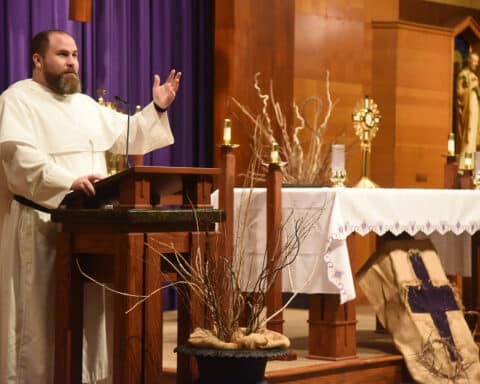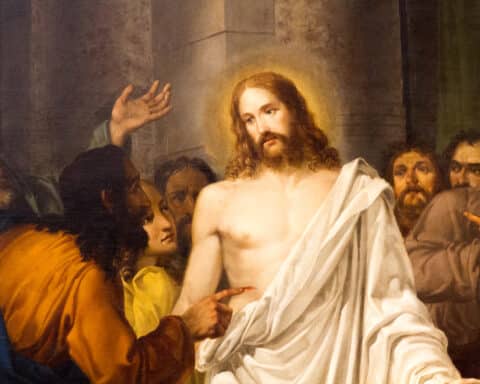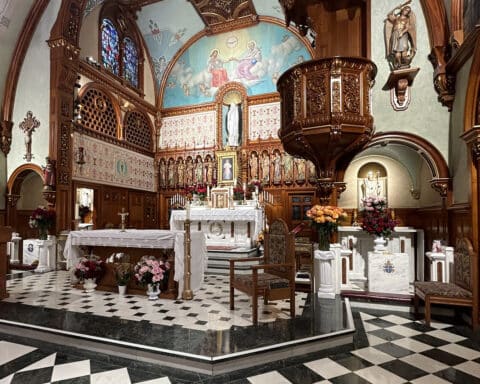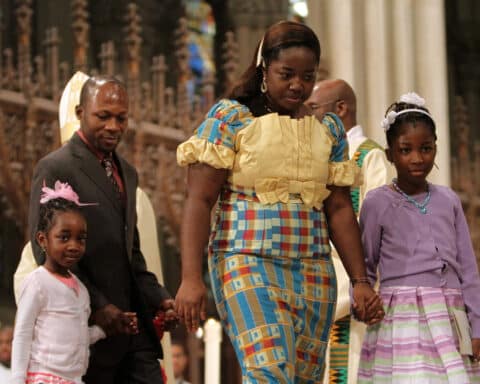Are you ready? Revival is coming!
On June 19, Corpus Christi Sunday, the National Eucharistic Revival kicks off across the United States. Cathedrals and churches everywhere will hail the Real Presence of Our Lord in the Blessed Sacrament, bringing more people closer to Christ.
However, preparing for a revival doesn’t mean donning sackcloth and ashes. True revival starts in the heart. One way to spark Eucharistic revival is by taking a road trip to an adoration shrine or chapel. You’ll never forget adoring the Real Presence in the country’s largest monstrance or seeing the Gothic monstrance caught — literally — by a fisherman! And you will be inspired to pray in the chapel that held the nation’s longest stretch of adoration.
Here are 10 of the country’s most intriguing Eucharistic destinations. Some are grand churches; others, wee chapels. But all tell fascinating stories and echo the prayer: “O Sacrament most holy, O Sacrament divine. All praise and all thanksgiving be every moment thine.”
St. Clement Eucharist Shrine — Boston
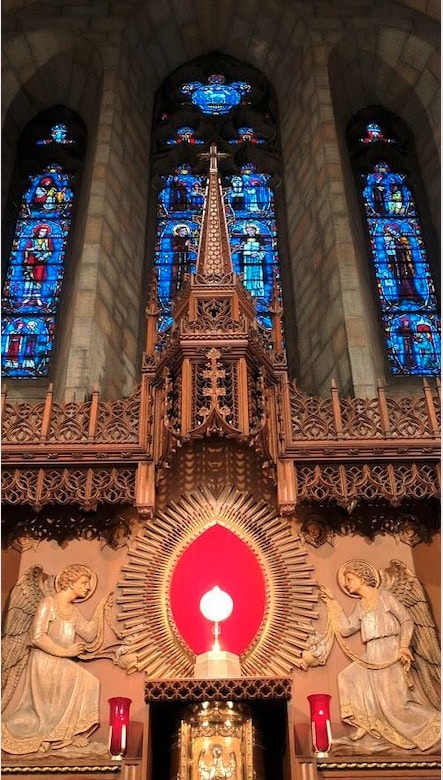 The “spiritual powerhouse” of Boston, St. Clement Eucharistic Shrine, didn’t begin as a shrine or even as a Catholic church. The Second Universalist Society of Boston built the neo-Gothic edifice in 1925 and named it the Church of the Redemption. Others dubbed it “The Church Beautiful.” One early writer noted, “To enter the church with others on Sunday or alone on a weekday is to feel the presence of the Eternal.”
The “spiritual powerhouse” of Boston, St. Clement Eucharistic Shrine, didn’t begin as a shrine or even as a Catholic church. The Second Universalist Society of Boston built the neo-Gothic edifice in 1925 and named it the Church of the Redemption. Others dubbed it “The Church Beautiful.” One early writer noted, “To enter the church with others on Sunday or alone on a weekday is to feel the presence of the Eternal.”
But the “Eternal” had other plans for the stately church with an Old World monastic feel. After the stock market crashed in 1929, the society’s membership dwindled and the coffers dried up. The Boston archdiocese bought the property in 1935 and called it St. Clement Chapel — named for St. Clement, the fourth pope who was martyred c. A.D. 100. A decade later, it became St. Clement Eucharistic Shrine. The Oblates of the Virgin Mary oversee the 24/7 adoration shrine.
To worship here is to pray with angels. Gigantic carved angels with censers adorn the oak reredos with Eucharistic throne. Below the angels — copies of Fra Angelico’s artworks — are Latin words that translate to, “This is the Bread which came down from Heaven. Behold the Bread of Angels, made the food of pilgrims.” Even the spectacular rose window praises the Lord. Like a kaleidoscope, your eye travels to the round center, reminiscent of the host in a monstrance.
Basilica of the National Shrine of the Assumption of the Blessed Virgin Mary — Baltimore
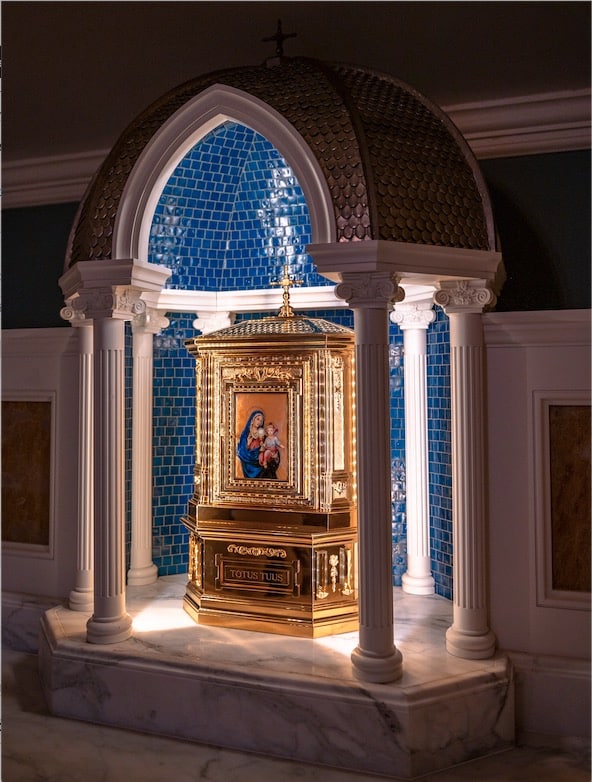
Dedicated on May 13, 2021, the St. John Paul II Eucharistic Adoration Chapel will whisk you to heaven. The gold-plated tabernacle features a stunning enamel image of the Blessed Mother holding the Child Jesus, a chalice with a host in his hand. Inscribed on the tabernacle base is the pope’s motto, “Totus Tuus” (“All yours”). Adding to the splendor, the tabernacle sits in a miniature eight-sided baldachin, lined with blue shingles.
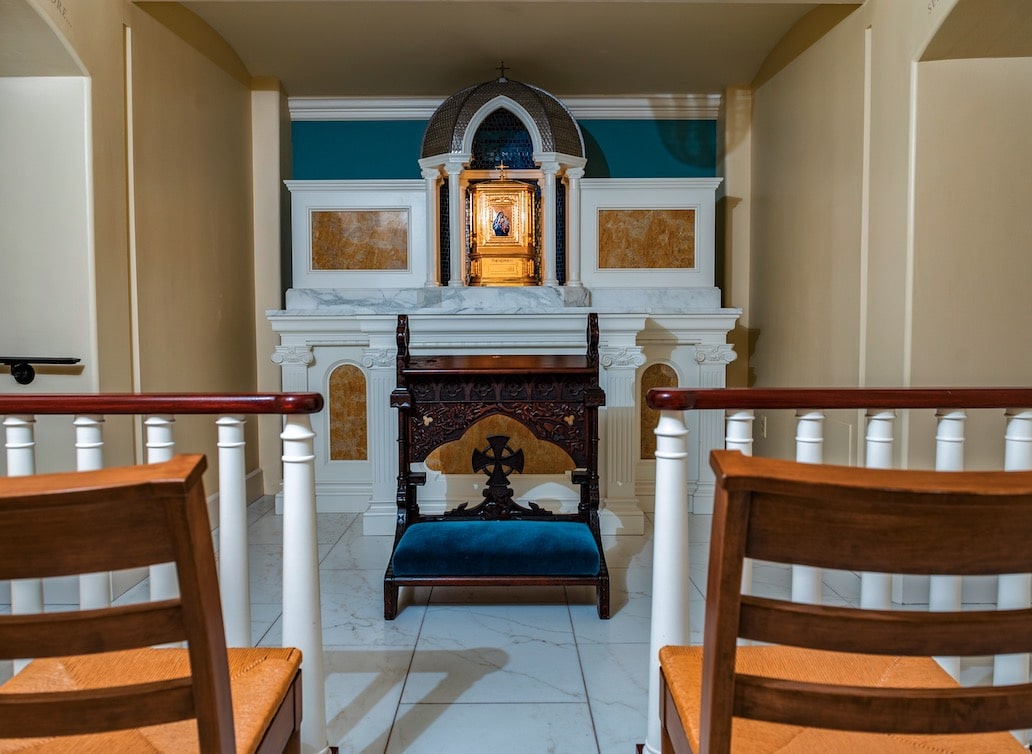
The main upper church holds a mysterious Gothic monstrance, hooked by a fisherman in a local reservoir. How it got there, nobody knows. But didn’t Jesus tell his apostles — the first fishers of men — to “put out into the deep?”
Shrine of the Most Blessed Sacrament — Hanceville, Alabama
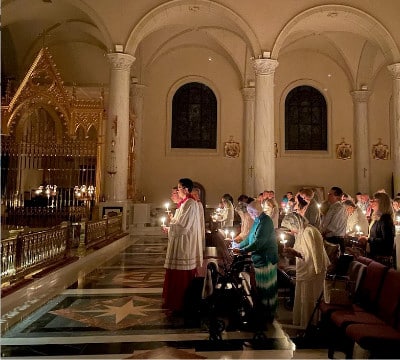
And what a temple it is! Everything — from the Divine Child statue greeting you on the expansive piazza, to the nearly eight-foot-tall monstrance in the 13th-century Italian-style shrine church — exalts the Lord of hosts. You can’t help but double genuflect before the tabernacle, a scaled-down replica of a Gothic church. The inlaid jasper crosses on the marble floor recall the ornamentation of the Jerusalem temple.
Outside, a walking path takes you to the Stations of the Most Holy Eucharist, 12 scriptural events depicting the Eucharist. Old Testament stations include the Passover and Elijah and the hearth cakes. Beginning with the nativity, New Testament stations include the wedding feast at Cana and the Last Supper.
National Shrine of St. Maximilian Kolbe at Marytown — Libertyville, Illinois
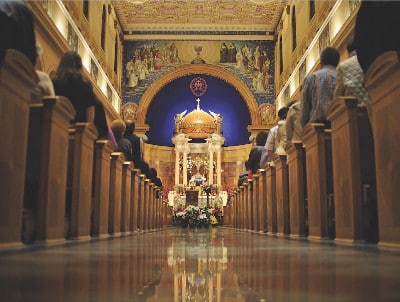
Can you find the pelican? The multiplied loaves?
Eucharistic adoration at Marytown began in 1928, when the Benedictine Sisters of Perpetual Adoration of Clyde, Missouri, instituted 24/7 prayer in the Our Lady of the Blessed Sacrament Chapel. Modeled after the Basilica of St. Paul Outside-the-Walls in Rome, the regal chapel hails the Real Presence in statues, mosaics, Latin inscriptions and a life-size monstrance crafted entirely from gifts of precious jewelry. Stained-glass angels — bearing the sacred vessels and vestments for Mass — process toward the marble high altar.
In 1978, the Conventual Franciscans of Kenosha, Wisconsin, bought the chapel, where perpetual adoration continues to this day. The friars also began the National Shrine of St. Maximilian Kolbe. In the Passion/Kolbe Chapel, an 11-foot-tall mosaic depicts the World War II martyr rising above the flames of Auschwitz.
St. Stanislaus Kostka Church — Chicago
When the sanctuary curtains parted on May 31, 2008 — the feast of the Visitation — at St. Stanislaus Kostka Church and revealed a nine-foot-tall monstrance, hearts stopped and jaws dropped. Our Lady of the Sign, Ark of Mercy is unlike any monstrance! The iconic vessel portrays the Blessed Mother atop a gold-leafed ark flanked by two golden angels, their gigantic wings sheltering her. Encased in Our Lady’s center is a one-foot luna that holds the sacred host, surrounded by a crown of thorns. One title for Mary is the Ark of the Covenant.
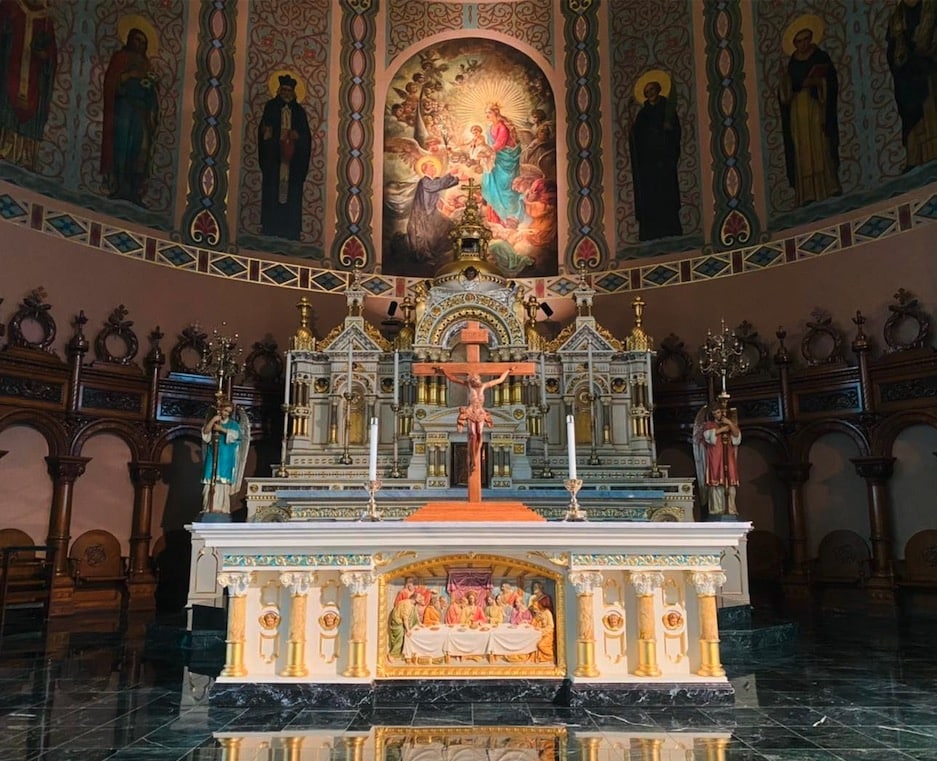
In 1999, Father Anthony Bus, of the Resurrectionist Congregation, was making a 33-day consecration to Jesus through Mary. One day while praying about the struggling parish, Father Bus relates in “A Mother’s Plea,” Our Lady interiorly told him, “Give me the parish. Make me mother and queen of the parish.” He did, sparking a parish revival. Mass attendance spiked. Confession lines grew. But people yearned for more. So, the parish created the Sanctuary of the Divine Mercy inside the church and threw open the church doors for perpetual adoration. The parish hasn’t been the same since.
St. Rose Convent — La Crosse, Wisconsin
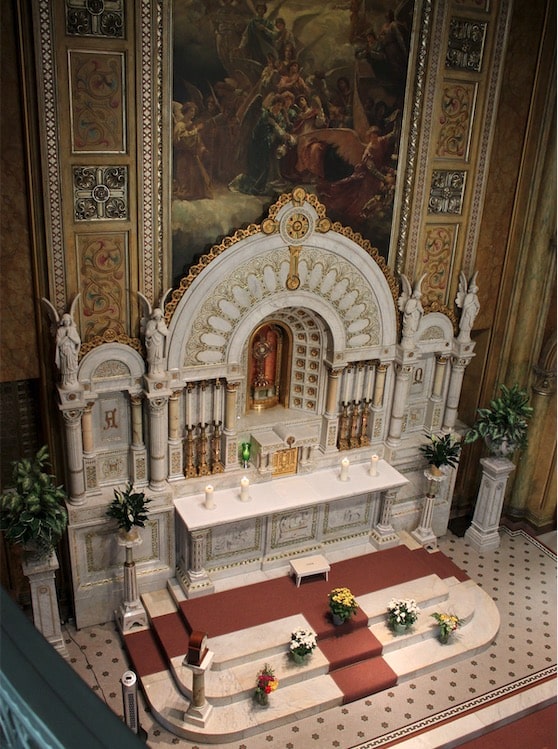
It took “prayer power” to even get the chapel. During the 1870s, Mother Antonia repeatedly begged the bishop to establish perpetual adoration in the convent. The bishop always refused, saying there weren’t enough sisters to sustain 24/7 prayer. The sisters looked to God and began praying in pairs, in two-hour shifts, before an empty ciborium. Sometime later, the bishop rapped at the convent door. He had changed his mind.
The sisters built a 12×18-foot shrine for their divine guest, and on Aug. 1, 1878, the prayer chain began. In 1906, the current Adoration Chapel opened. Kneeling 30, the Romanesque-style temple features a gleaming white marble altar and stained-glass choirs of “all-seeing” angels ready for spiritual battle: The angels’ feathers have eyes.
Holy Angels Catholic Church — Basehor, Kansas
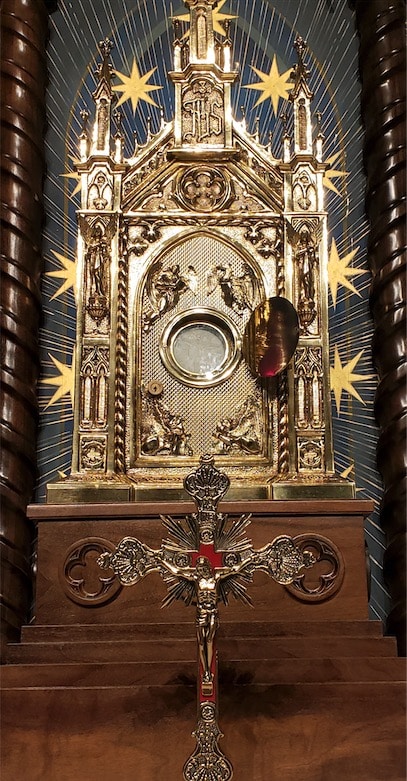
Erected in medieval style, the Kansas Portiuncula is decked with Gothic arches — on the pews and the reredos, in the shape of the doors and the contour of the chapel, and even on the bronze tabernacle with spires. Wood-carved statues portray Francis with the stigmata and St. Clare, the first female follower of Francis, with a monstrance. When Saracens attacked her Assisi convent, Clare held a monstrance aloft. Overcome by the Real Presence, the army fled. A field of 144 stars (the biblical number of perfection) adorns the deep blue ceiling.
The “Little Chapel on the Kansas Prairie” also imitates the facade of the Portiuncula. Depicting the “Pardon of Assisi,” a mural over the entrance shows St. Francis kneeling before Jesus, Our Lady and the angels, pleading for pardon for all who come here to worship the Lord.
Our Lady of Corpus Christi Retreat Center — Corpus Christi, Texas
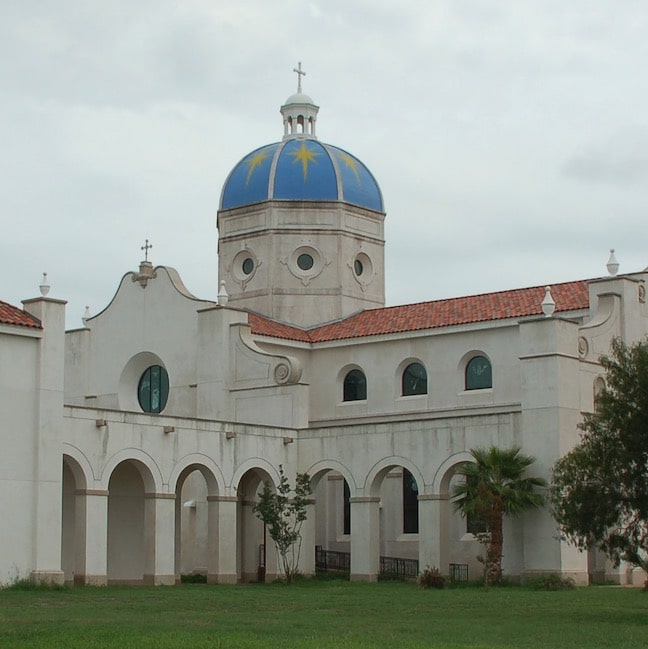
For years Father James Kelleher, of the Society of Our Lady of the Most Holy Trinity, had a vision for Our Lady of Corpus Christi Retreat Center: an adoration chapel just as spectacular as Mother Angelica’s shrine in Hanceville, Alabama, but in local Spanish Colonial style. But money was scarcer than snow in South Texas.
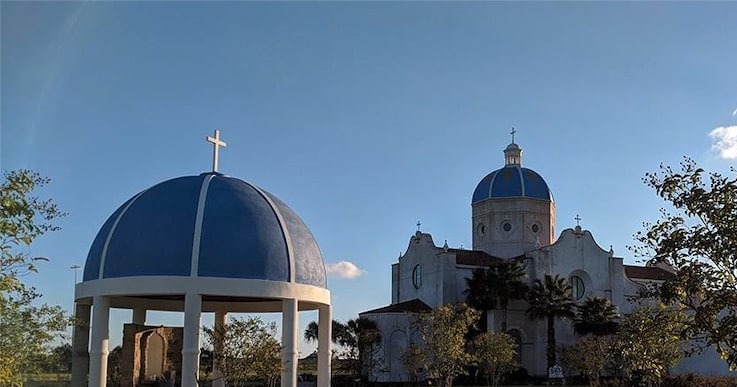
Dedicated in 2003 and seating 250, the chapel’s spiritual heart is a captivating 40-foot-tall wooden reredos in Spanish Baroque design. Eyes gravitate to a large painted relief of the Blessed Mother and John at the Crucifixion in the center, then ascend to a golden four-foot monstrance at the summit. Two cherub gaze at worshippers below, ready to wing their prayers — and dreams — to heaven.
Chapel of Blessed Pier Giorgio Frassati — Vancouver, Washington
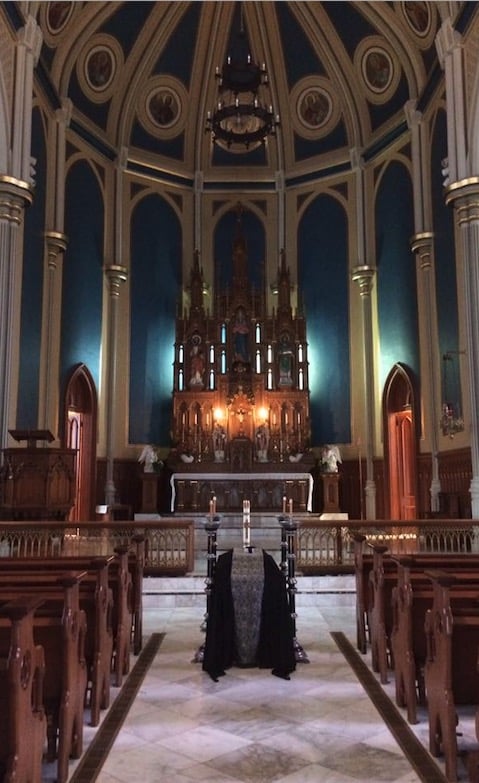
Erected in 2019, the tiny Gothic-style brick chapel seats only eight, but what a unique throne room for the Eucharistic king. The walls are painted a pure white, the metallic gold ceiling forming a crown above the tabernacle — the original tabernacle from the first St. James Church at Fort Vancouver. There are no statues, not even a crucifix. Adorers focus solely on Jesus present in the Blessed Sacrament.
A framed photograph of Frassati — touched to the bed in which he died in Torino, Italy — inspires adoration. According to lore, the “saint on skis” would become so enraptured after receiving Our Lord in holy Communion that people would tiptoe past him. Once, when melted wax from candles dripped on his coat, he didn’t even notice. He had reached “the heights.”
Cathedral of the Blessed Sacrament — Sacramento, California
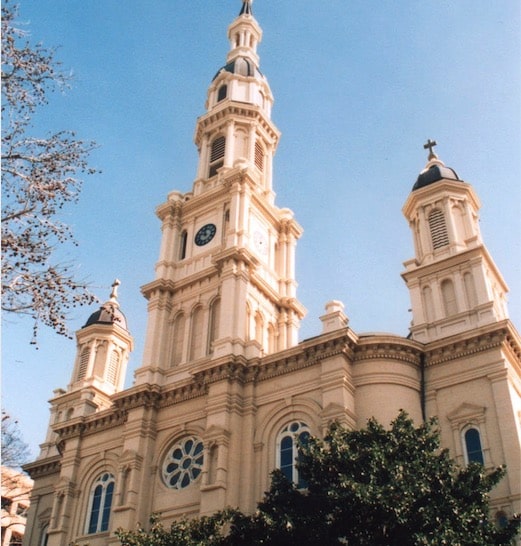
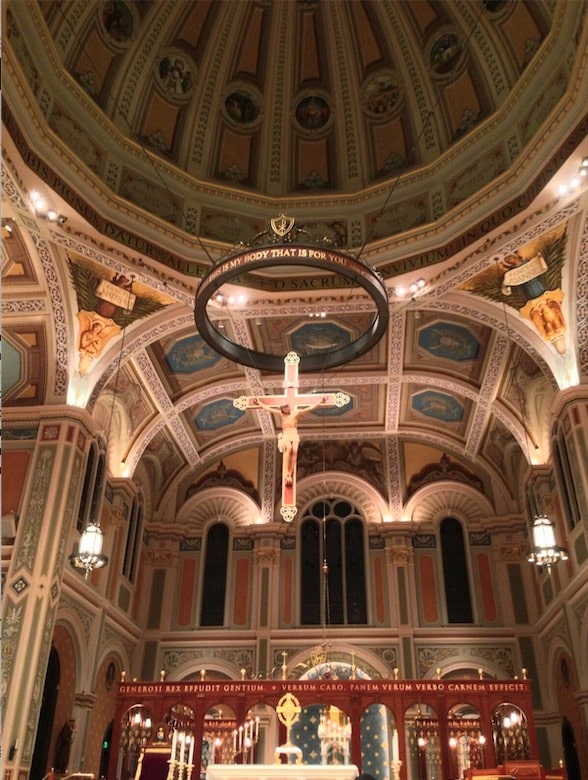
The cathedral also boasts an 8×10-foot exact reproduction of Raphael’s “The Sistine Madonna,” one of only two such copies in the world.
Marion Amberg is an award-winning journalist and the author of “Monuments, Marvels, and Miracles: A Traveler’s Guide to Catholic America” (OSV, $27.95).
| JOIN THE PROCESSION |
|---|
|
Corpus Christi processions began in 13th-century Europe, when priests would carry the Blessed Sacrament through villages and the countryside. Onlookers genuflected, and it’s said that even beasts bent their forelegs in adoration. In 1264, Pope Urban IV established the Solemnity of the Most Holy Body and Blood of Jesus. Corpus Christi processions vary by country and culture. Most American processions are made on foot, others by car. There’s even a floating procession down a Louisiana bayou. One Midwestern church fetes Our Lord with a bang. Holy Family Church, Oldenburg, Indiana The colorful procession wends through the German village, stopping at five outdoor altars adorned with the ladies’ finest tablecloths and polished candlesticks. After hymns and prayers, a drum roll announces the Benediction. As the priest blesses the crowd with the monstrance, the shooters salute the Eucharistic king with a salvo of gun blasts. “The Father.” Bang! “The Son.” Bang! “The Holy Spirit.” Bang! God’s parade then moves to the next altar, where the holy drama is repeated. Holy Family Parish, Sanilac County, Michigan Like Jesus entering Jerusalem on Palm Sunday, other motorists pulled over and made way for the King. Our Lord was passing them by. Fête-Dieu du Teche, Bayou Teche, Louisiana After a French Mass at St. Leo the Great Catholic Church in Leonville, clergy and pilgrims process to the town’s boat landing. Leading the flotilla is the “Jesus boat,” a floating adoration chapel with a six-foot monstrance. Then comes “Mary’s boat,” with a large statue of Mary’s Assumption, and a “congregation” of boats of all kinds. The boat pilgrimage stops at makeshift altars along the Teche, where throngs are waiting onshore to pray the Rosary and for Benediction. Mobile confessionals are set up at each stop. The day-long fete concludes downstream at St. Martinville, with vespers and a final Benediction. |

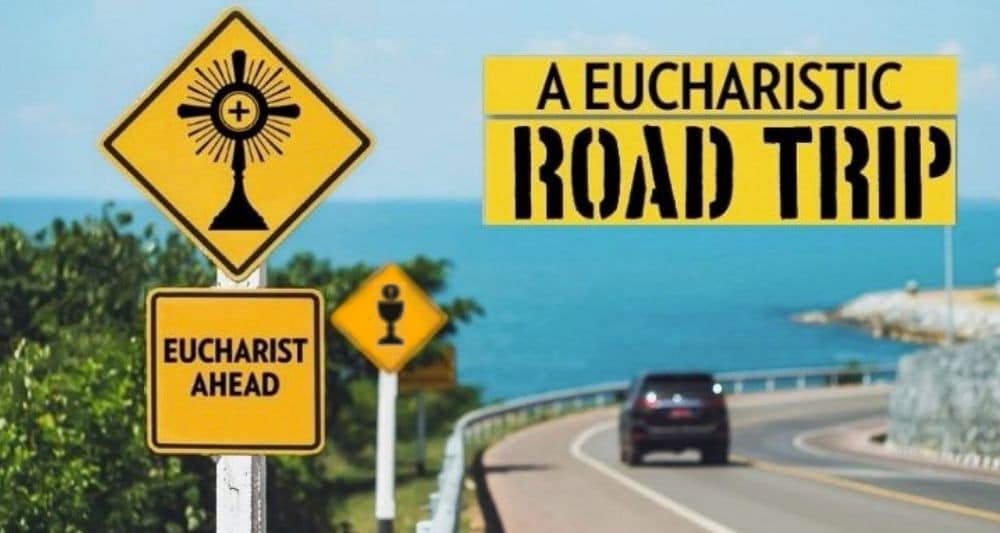
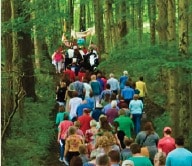 Dubbed the “Village of Spires,” tiny Oldenburg is home to Holy Family Church and the country’s oldest parish Corpus Christi procession. Dating from 1846, the 176-year-old tradition has changed little over the years. Cross and flag bearers lead the entourage, followed by altar servers, children strewing flowers, and four men holding high a canopy to shelter the priest carrying the monstrance. St. John’s Knights with swords, parishioners and tourists, drummers, and “shooters” — a military guard — bring up the rear.
Dubbed the “Village of Spires,” tiny Oldenburg is home to Holy Family Church and the country’s oldest parish Corpus Christi procession. Dating from 1846, the 176-year-old tradition has changed little over the years. Cross and flag bearers lead the entourage, followed by altar servers, children strewing flowers, and four men holding high a canopy to shelter the priest carrying the monstrance. St. John’s Knights with swords, parishioners and tourists, drummers, and “shooters” — a military guard — bring up the rear.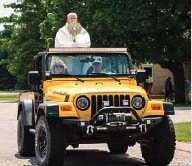 In 2021, the Catholic faithful of Sanilac County took Jesus out into the world in a unique Corpus Christi procession: A Eucharistic caravan with a police escort. Standing in the back of a bright yellow open Jeep, Father Stephen Blaxton, pastor of Holy Family Parish in Sanilac County, held the monstrance aloft. As the caravan of over 70 cars traveled to the parish’s three churches in Marlette, Peck and Sandusky, worshippers prayed the Rosary and the Litany of the Most Blessed Sacrament.
In 2021, the Catholic faithful of Sanilac County took Jesus out into the world in a unique Corpus Christi procession: A Eucharistic caravan with a police escort. Standing in the back of a bright yellow open Jeep, Father Stephen Blaxton, pastor of Holy Family Parish in Sanilac County, held the monstrance aloft. As the caravan of over 70 cars traveled to the parish’s three churches in Marlette, Peck and Sandusky, worshippers prayed the Rosary and the Litany of the Most Blessed Sacrament.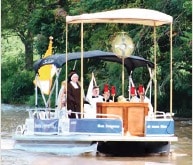 It’s a “floating church” at the
It’s a “floating church” at the 